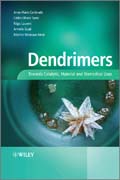
Dendrimers: towards catalytic, material and biomedical uses
Caminade, Anne-Marie
Turrin, Cedric-Olivier
Laurent, Regis
This book will be mainly focussed on the properties and uses of dendrimers and dendrons. The aim of this book is to be the reference book about dendrimers applications. It will not describe all details, but it will give the reader a unique overview of what has currently been done with dendrimers, with numerousreferences and illustrations. It will be divided in four main parts: Part 1) Generalities, syntheses, characterizations and properties; Part 2) Applications in catalysis; Part 3) Applications for the elaboration or modification of materials; and Part 4) Applications in biology/medicine. The role of the nanometric size and the multiple functions of dendrimers on the properties will be emphasized. ÍNDICE: Preface Part 1) Generalities, syntheses, characterizations and physico-chemical properties Chapter 1: Syntheses of Dendrimers and Dendronsby Anne-Marie Caminade 1 Introduction: what Are Dendrimers and Dendrons?2 Syntheses of Poly(Propyleneimine) Dendrimers (PPI)3 Synthesis of Poly(Amidoamine) Dendrimers (PAMAM)4 Syntheses of Poly(Ether) Dendrimers5 Syntheses of Poly(Ester) Dendrimers6 Synthesis of Poly(Lysine) Dendrimers7 Syntheses of Silicon-Containing Dendrimers8 Syntheses of Phosphorus-Containing Dendrimers9 Syntheses of Carbon-Based Dendrimers10 Syntheses of Dendrimers Constituted of Nitrogen Heterocycles11 Syntheses by Self-Assembly12 Accelerated Syntheses13 Conclusion14 References Chapter 2: Methods of Characterization of Dendrimersby Anne-Marie Caminade 1. Introduction2. Spectroscopy and Spectrometry2.1. Nuclear Magnetic Resonance (NMR)2.2. Mass Spectrometry2.3. X-ray Diffraction2.4. Infra-Red (IR) and Raman Spectroscopy2.5. Ultra-Violet-Visible (UV-vis) Spectroscopy2.6. Fluorescence2.7. Chirality, Optical Rotation, Circular Dichroism (CD)2.8. Electron Paramagnetic Resonance (EPR)2.9. Electrochemistry2.10. Magnetometry2.11. MössbauerSpectroscopy2.12. X-ray Spectroscopies3. Scattering Techniques3.1. Laser Light Scattering (LLS)3.2. Small Angle Neutron Scattering (SANS)3.3. Small Angle X-ray Scattering (SAXS) and Wide Angle X-ray Scattering (WAXS)4. Microscopy4.1.Transmission Electron Microscopy (TEM)4.2. Atomic Force Microscopy (AFM)4.3. Polarizing Optical Microscope5. Rheology and Physical Characterizations5.1. Intrinsic Viscosity5.2. Differential Scanning Calorimetry (DSC)5.3. Dielectric Spectroscopy (DS)5.4. Dipole Moments6. Separation Techniques6.1. Size ExclusionChromatography6.2. Electrophoresis7. Conclusion8. References Chapter 3: Luminescent Dendrimersby Anne-Marie Caminade 1. Introduction2. Dendrimers with Fluorescent Terminal Groups2.1. Fully Substituted Dendrimers2.2. Partially Substituted Dendrimers3. Luminescent Group at the Core of Dendrimers and Energy/Light-Harvesting Properties3.1. Organic Fluorophores as Cores3.2. Porphyrins and Phthalocyanines as Cores3.3. Metallic Cores4. Fluorescent Groups inside the Structure of Dendrimers5. Intrinsically Fluorescent Dendrimers5.1. Fluorescent Groups throughout the Dendrimeric Structure5.2. Fluorescence of Dendrimers without Known Fluorophores6. Two-Photon-Excited Fluorescence of Dendrimers7. Conclusion8. References Chapter 4: Stimuli-Responsive Dendrimers by Anne-Marie Caminade 1. Introduction2. Photo-Responsive Dendrimeric Structures2.1. Azobenzene-Containing Dendrimers and Dendrons2.2. Other Types of Photo-Responsive Dendrimers3. Thermo-Responsive Dendrimeric Structures3.1. Thermo-responsive Properties of Dendrimers3.2. Thermo-responsive Properties of Dendrons and Dendronized Polymers4. Dendrimers Responsive to Solution Media Changes4.1. pH-Responsive Dendrimers4.2. Dendrimers Disassembly5. Conclusion6. References Chapter 5: Liquid Crystalline Dendrimersby An
- ISBN: 978-0-470-74881-7
- Editorial: John Wiley & Sons
- Encuadernacion: Cartoné
- Páginas: 528
- Fecha Publicación: 02/09/2011
- Nº Volúmenes: 1
- Idioma: Inglés
